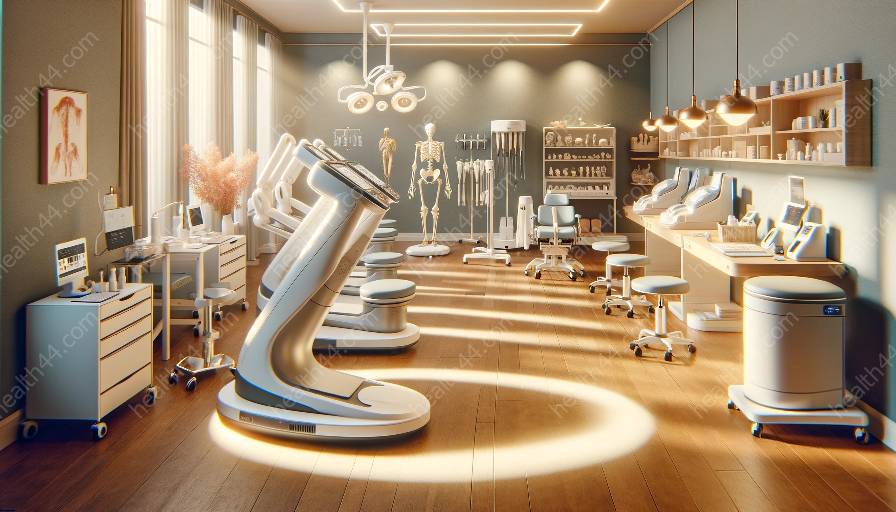Orthopedic diagnostic equipment plays a crucial role in the field of orthopedic equipment and medical devices & equipment. It encompasses a wide range of innovative technologies and tools designed to diagnose various musculoskeletal conditions and injuries, enabling healthcare professionals to provide accurate and timely treatments.
By delving into the advancements and applications of orthopedic diagnostic equipment, we can gain a better understanding of how these technologies are revolutionizing the orthopedic care landscape.
Technological Advancements in Orthopedic Diagnostic Equipment
The relentless pursuit of innovation has led to significant advancements in orthopedic diagnostic equipment. These technologies are instrumental in improving diagnostic accuracy, enhancing patient experience, and facilitating better clinical outcomes.
1. Digital Radiography
Digital radiography has replaced traditional film-based X-ray systems, offering numerous advantages such as lower radiation exposure, faster image acquisition, and the ability to digitally enhance and manipulate images for improved diagnostic clarity.
2. MRI and CT Scanners
Magnetic resonance imaging (MRI) and computed tomography (CT) scanners have become essential tools for orthopedic diagnostics, providing detailed cross-sectional images of the musculoskeletal system. Recent technological advancements have led to the development of high-field MRI systems and multi-slice CT scanners, offering superior image quality and faster scan times.
3. Ultrasound Imaging
Ultrasound imaging is widely used to diagnose soft tissue injuries, muscle tears, tendon abnormalities, and joint diseases. Advances in ultrasound technology have resulted in higher resolution images, real-time visualization, and portable systems for point-of-care diagnostics.
4. 3D Imaging and Augmented Reality
Emerging technologies such as 3D imaging and augmented reality are transforming orthopedic diagnostics by providing comprehensive anatomical views, accurate measurements, and immersive visualization for surgical planning and intervention.
Integration with Orthopedic Equipment
Orthopedic diagnostic equipment is closely integrated with a wide array of orthopedic devices and instruments, allowing seamless workflows and comprehensive patient assessment.
1. Surgical Navigation Systems
Advanced imaging modalities are integrated with surgical navigation systems, enabling orthopedic surgeons to precisely plan and execute complex procedures such as joint replacement surgeries and spinal interventions.
2. Orthopedic Implants and Prosthetics
Accurate diagnostic imaging facilitates the customization and precise placement of orthopedic implants and prosthetics, ensuring optimal functional outcomes and long-term patient satisfaction.
3. Rehabilitation and Physiotherapy Devices
Orthopedic diagnostic equipment aids in the assessment of musculoskeletal injuries and conditions, guiding the development of personalized rehabilitation and physiotherapy regimens for patients in need of therapeutic interventions.
Role in Medical Devices & Equipment
Orthopedic diagnostic equipment is a pivotal component of the broader landscape of medical devices and equipment, influencing advancements across various specialties and healthcare settings.
1. Regulatory Compliance and Quality Assurance
These technologies contribute to ensuring regulatory compliance and quality assurance in the design, manufacturing, and performance evaluation of orthopedic devices and medical equipment.
2. Research and Development
Orthopedic diagnostic equipment serves as a fundamental tool for research and development, facilitating the evaluation of novel materials, implant designs, and treatment modalities in orthopedic and musculoskeletal healthcare.
3. Patient-Centric Care
By enabling precise diagnostics and treatment planning, orthopedic diagnostic equipment promotes a patient-centric approach, enhancing the overall quality of care and patient outcomes.
Future Directions and Innovations
The future of orthopedic diagnostic equipment holds immense promise, with ongoing research and development efforts focused on enhancing imaging technologies, expanding the scope of point-of-care diagnostics, and integrating artificial intelligence for data analysis and predictive modeling.
Current Challenges and Opportunities
While orthopedic diagnostic equipment has made remarkable strides, challenges such as cost constraints, technological integration complexities, and standardization issues present opportunities for collaboration and innovation within the orthopedic and medical devices & equipment industries.
Orthopedic diagnostic equipment stands as a beacon of transformative technologies, shaping the present and future of orthopedic care and contributing significantly to the evolution of medical devices & equipment. By embracing these cutting-edge advancements, healthcare professionals and patients alike can look forward to improved diagnostic accuracy, personalized treatments, and enhanced outcomes.


